Domande - introduzione
From LimeSurvey Manual
Introduzione
Una volta creati i gruppi (vedere: creazione di gruppi) si possono aggiungere le domande in ciascun gruppo.
Sono disponibili più modi per farlo, due dei quali sono illustrati in seguito.
- È possibile aggiungere domande dal menù della struttura del sondaggio;
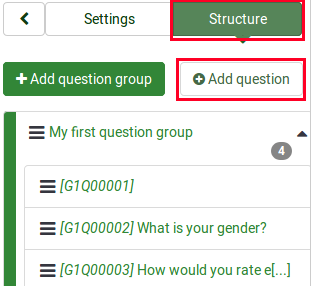
- Accedi a un gruppo di domande e cerca il pulsante di azione rapida "aggiungi domanda";
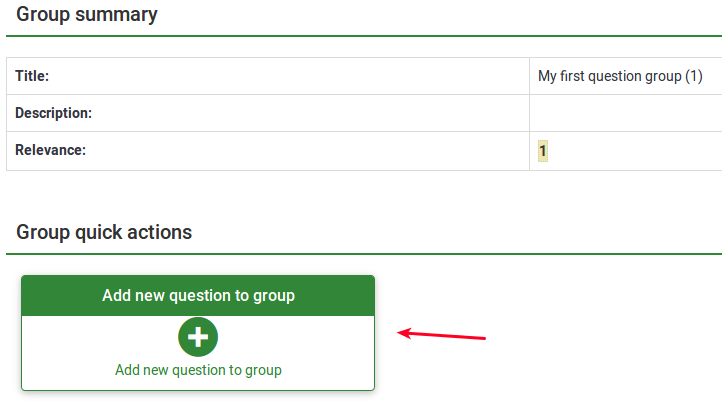
Descrizione delle opzioni
Quando si aggiunge una domanda è necessario indicare un "codice domanda", il testo della domanda, la nota di spiegazione e le opzioni generali:
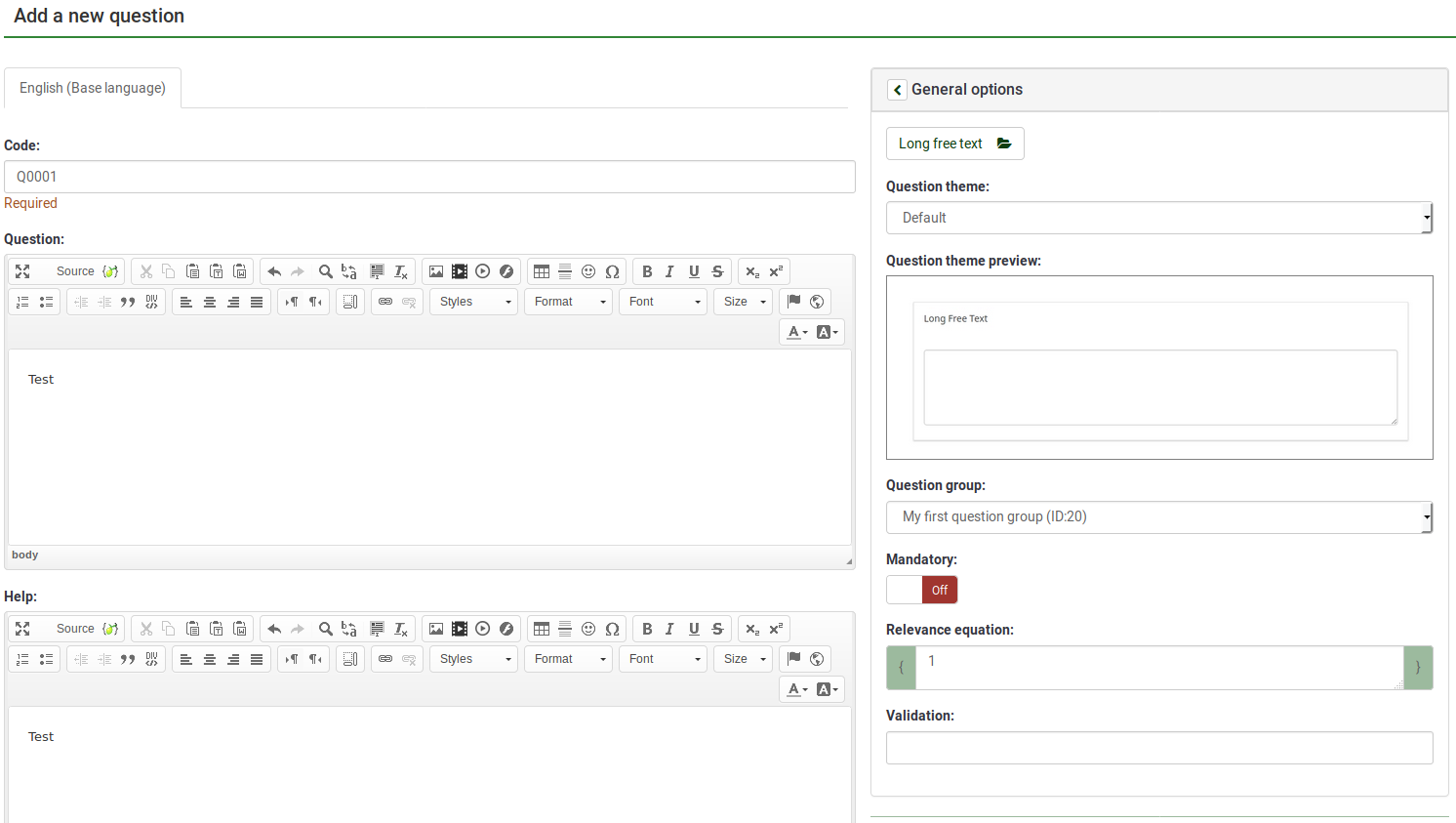
- Question code: It represents the ID, number or code for the question that is used for quick identification. This field is normally not displayed to people taking the survey unless specified in the Presentation panel - Show question number and/or code. It is especially useful if you wish to use the LimeSurvey assessments feature and/or the ExpressionScript.
- Domanda: è il testo della domanda che verrà visualizzato dagli utenti. Non c'è un limite massimo di caratteri utilizzabili, tuttavia per l'inserimento di note e spiegazioni di compilazioni è preferibile l'utilizzo dell'opzione "Nota di spiegazione". E' anche possibile usare codice HTML, ad esempio per includere immagini.
<img src="http://www.yourdomain.com/yourpics/pic.jpg">
- Help: This is an optional field. It is useful if a question needs some explanation or you want to explain how it should be answered. When you put text in this field, a "question mark" icon appears on the survey entry screens with the help text right beside it.
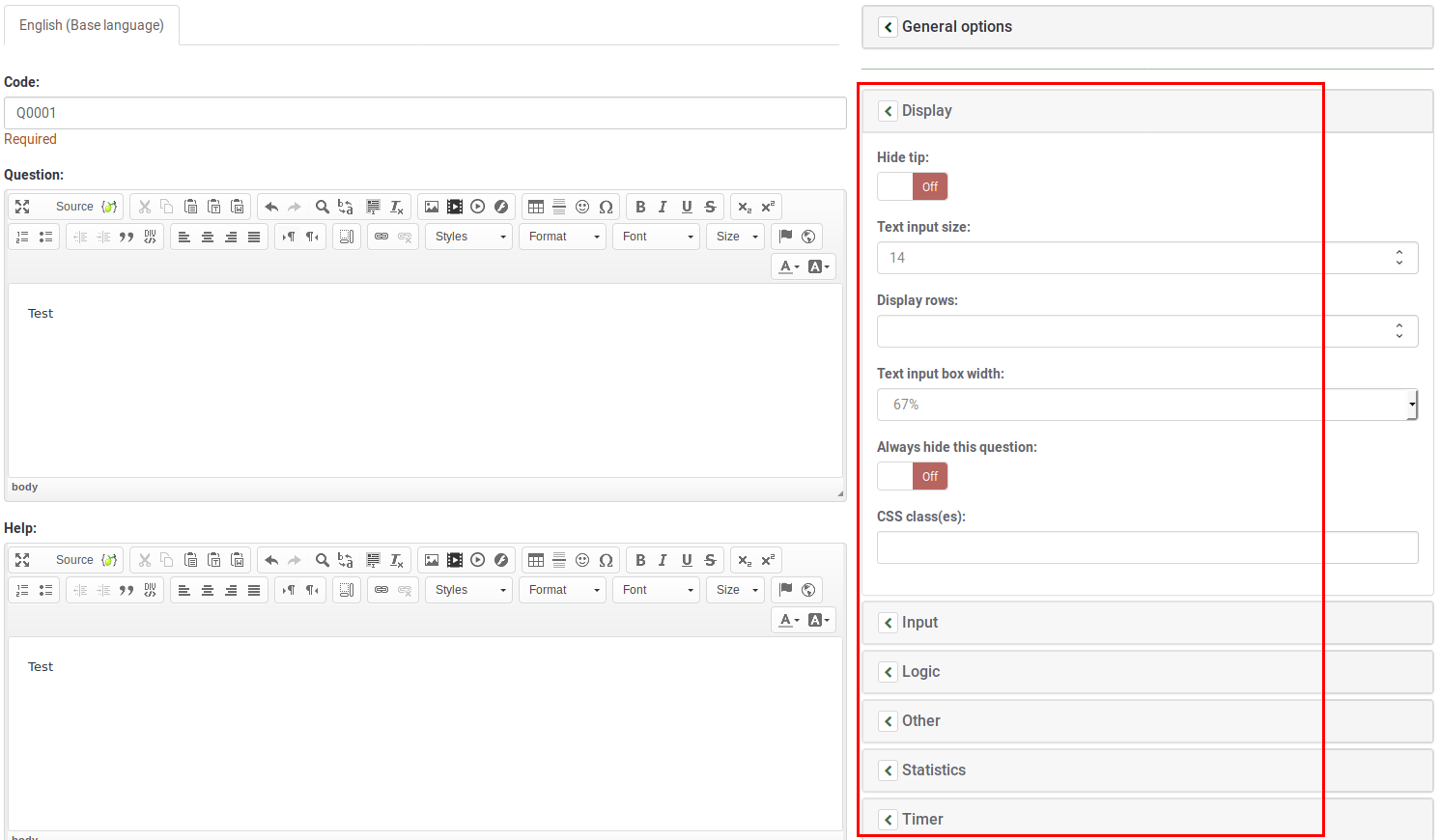
General options
Different tabs are displayed on the right part of the screen. The most basic and important one is the General options tab. The following question settings can be changed from here:
- Question type: This determines the type of response the survey allows. View the question types section for a description on the various available options.
- Question group: To change the question group of a question, select from the dropdown list the desired group.
- Validation: This feature is available in all text- and numeric- type questions. You can use standard regular expressions in this field to validate the responses to the question, and if the responses don't validate against this expression, the user will be prompted to try again before he or she can progress further.
- Opzione Altro: disponibile solo per alcune tipologie di domande. Se abilitata, permette all'intervistato di rispondere con una ulteriore specifica "altro" nel caso le opzioni predefinite non siano soddisfacenti.
- Obbligatorio: questa opzione obbliga il rispondente a fornire una risposta alla domanda, prima di spostarsi alla domanda o gruppo di domande successivo. Per la tipologia Classifica questo significa che tutti gli elementi devono essere classificati.
- Equazione di rilevanza: è l’equazione booleana che indentifica la condizione di visualizzazione della domanda. Se il valore è uguale a 1 (vero), la domanda viene sempre visualizzata dall'utente, altrimenti sarà nascosta e, dal momento che non è rilevante, nel database il suo valore sarà impostato a NULL.
Ulteriori detttagli sull'uso di questa opzione sono disponibili nella sezione wiki ExpressionScript.
- Encrypted: This setting is only available for some question types and determines if the saved response data is encrypted in the database. This gives an additional layer of security if your database gets hacked. However, it has some minor drawbacks, as you will not be able to search for partial texts in the response view and encrypting/decrypting also requires additional server resources.
- Save as default values: This setting allows you to save the settings of the current question type as default settings for new questions. If you set it to 'On', it will save the default values, then automatically reset to 'Off' after you saved.
- Clear default values: With this setting, you can reset any default values saved by the function 'Save as default values' and revert to system default values. If you set it to 'On', it will reset the default values, then automatically reset to 'Off' after you saves.
Si tratta di opzioni avanzate che sono diverse per ciascun tipo di domanda.
Si consiglia, quindi, di consultare la documentazione per ciascuno specifico tipo di domanda.Copiare una domanda o importarla da un'altra indagine
Nella parte superiore della pagina Aggiungere una nuova domanda può essere mostrata una barra degli strumetnti con diverse opzioni, tra le quali quella per l'importazione:
(1) From within a survey, click the Structure tab.
(2) From the Create question page, click Import a question at the top of the page.
The Import a question options will be displayed.
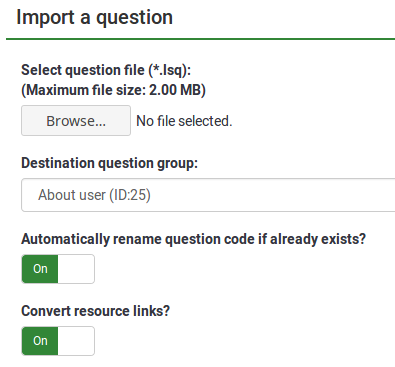
(3) Click Browse and select the .lsq file (which is the LimeSurvey question-type format).
(4) Select the Destination question group that you want to add the imported question into.
(5) Choose whether or not you would like to Automatically rename the question code if it already exits. If the question code already exists, enable this option to use another question code. You can also have two questions that use the same question code. However, some issues might appear if you use more complex LimeSurvey options such as the ExpressionScript or when you work with the exported data in R or SPSS (qcode becoming a value label).
(6) Choose whether or not to Convert resource links. This option is usually used together with the ExpressionScript to create advanced question types. If you use them together, complex branching, assessments, validation, and/or tailoring can be done.
(7) Click Import located on the upper right part of the screen.
The Question import summary will be displayed.
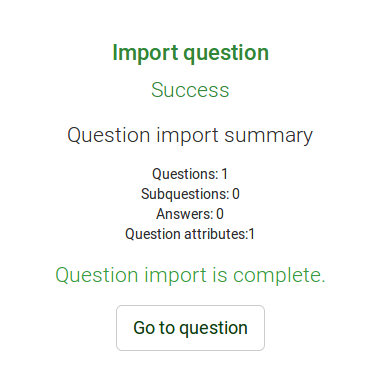
Informazioni dalla tabella dei partecipanti all'indagine
E' possibile personalizzare i testi delle domande con le informazioni contenute nei campi della tabella dei identificativi. Per fare ciò è indispensabile creare un'indagine con identificativi che non sia anonima.
The following placeholders can be used within a question:
| {TOKEN:FIRSTNAME} | inserisce il valore risultante nel campo "Nome" della tabella dei partecipanti |
| {TOKEN:LASTNAME} | inserisce il valore risultante nel campo "Cognome" della tabella dei partecipanti |
| {TOKEN:EMAIL} | inserisce il valore risultante nel campo "Email" della tabella dei partecipanti |
| {TOKEN:ATTRIBUTE_1} | inserisce il valore risultante nel campo "Attibuto_1" della dei partecipanti |
| {TOKEN:ATTRIBUTE_2} | inserisce il valore risultante nel campo "Attibuto_2" della dei partecipanti |
Per usare uno qualsiasi dei segnaposto mostrati in alto, essi devono essere trascritti nel modo in cui sono riportati nel testo della domanda. Ad esempio:
Ciao {TOKEN:FIRSTNAME}. Ti abbiamo inviato una mail all'indirizzo {TOKEN:EMAIL}. E' corretto?
If you wish to further customize your questions, use the [[ExpressionScript - Presentation|ExpressionScript]]. For example, if you wish to make use of the tailoring technique, type in:
<div class="mw-translate-fuzzy">
<syntaxhighlight lang="php" enclose="div">In qualità di {TOKEN:ATTRIBUTE_1} cosa pensi {if(TOKEN:ATTRIBUTE_1=='worker','del tuo capo','dei tuoi lavoratori')}?
Si può anche utilizzare JavaScript per ottenere una maggiore personalizzazione delle domande. Prima di tutto, si deve abilitare l'uso di Javascript nelle domande, disattivando il filtro XSS nelle Impostazioni globali di LimeSurvey. Tuttavia, disabilitare questa opzione non è sempre una cosa positiva. Si suggerisce di consultare la sezione wiki sulle impostazioni opzionali per ulteriori informazioni. Adattamento delle comande con JavaScript:
Hello {TOKEN:FIRSTNAME}. We sent an email to you using this address {TOKEN:EMAIL}. Is this correct?
What do you as a {TOKEN:ATTRIBUTE_1} think about your
<script type="text/javascript" language="Javascript">;
var job='{TOKEN:ATTRIBUTE_1}';
if (job=='worker') {
document.write ('bosses')
} else {
document.write('workers')
}
</script>
?
Informazioni da risposte precedenti
LimeSurvey consente di inserire la risposta ad una precedente domanda nel testo delle risposte ad una domanda successiva.
- Si può fare riferimento alle risposte della stessa pagina e anche adattare dinamicamente i messaggi al testo inserito nelle risposte.
- Si può utilizzare la nomenclatura dei codici domanda. Per maggiori informazioni, si veda la documentazione su ExpressionScript.
Nell'editor WYSIWYG HTML (FCKeditor) è stato integrato un wizard chiamato "LimeReplacementFields", che permette di inserire favilmente i codici domanda/risposta delle risposte precedenti. Per usare questo wizard, nel FCKeditor utilizzare il pulsante con il "limone tra parentesi graffe" e selezionare la domanda dalla lista visualizzata. La lista presenta solo le risposte precedenti alla domanda stessa.
In order to use this feature in the FCKeditor:
(1) Click the "lime between brackets" icon.
(2) Select a question from the select box.

Only answers from previous pages are displayed.
Formattazione delle domande
E' possibile definire una formattazione/layout di base delle domande utilizzando i file CSS con l'editor dei temi.
